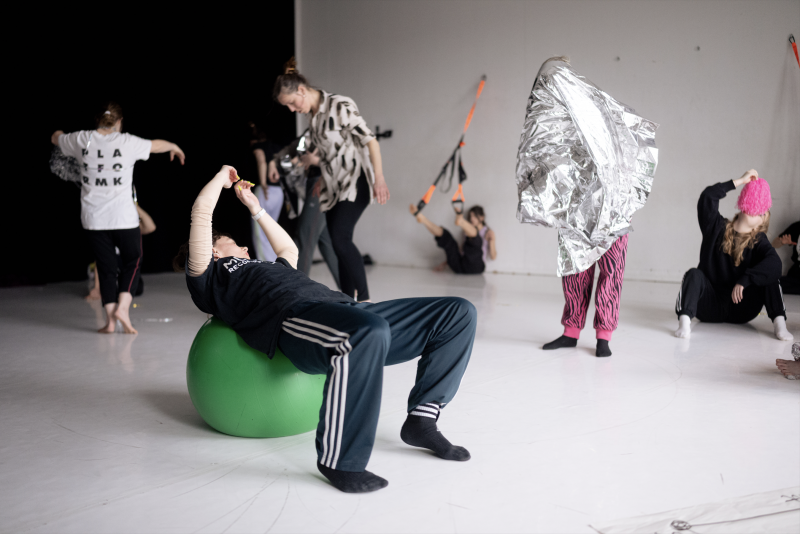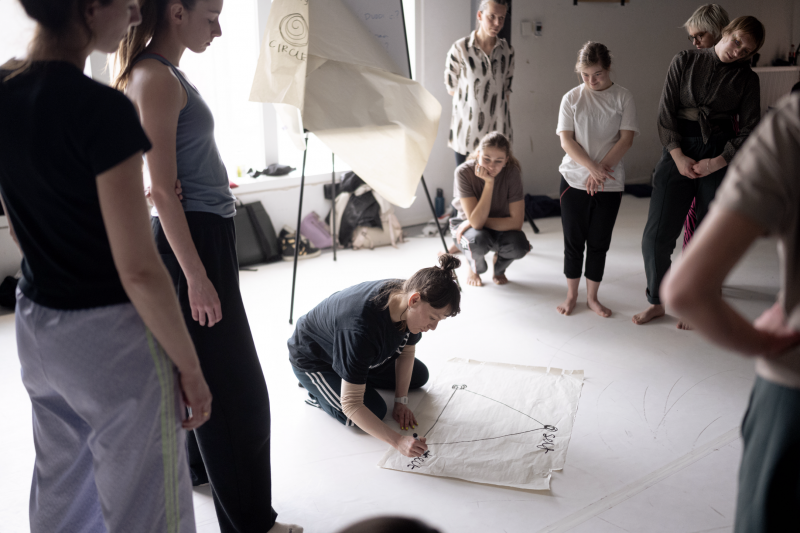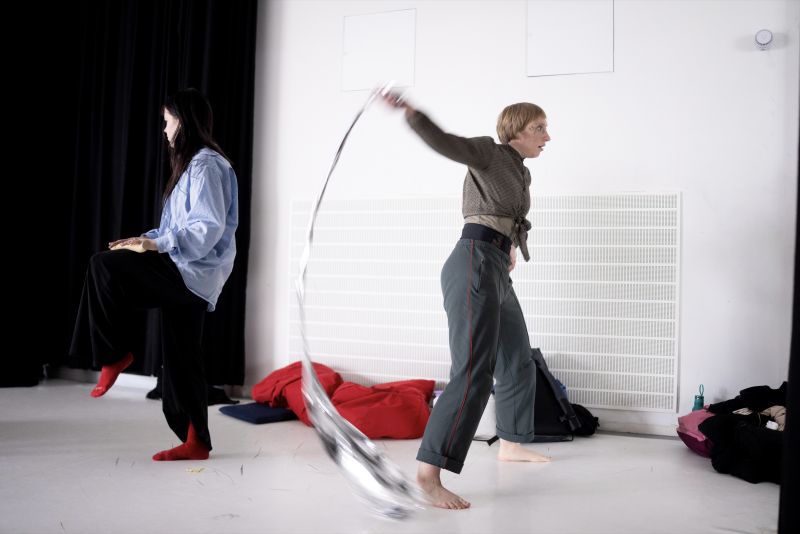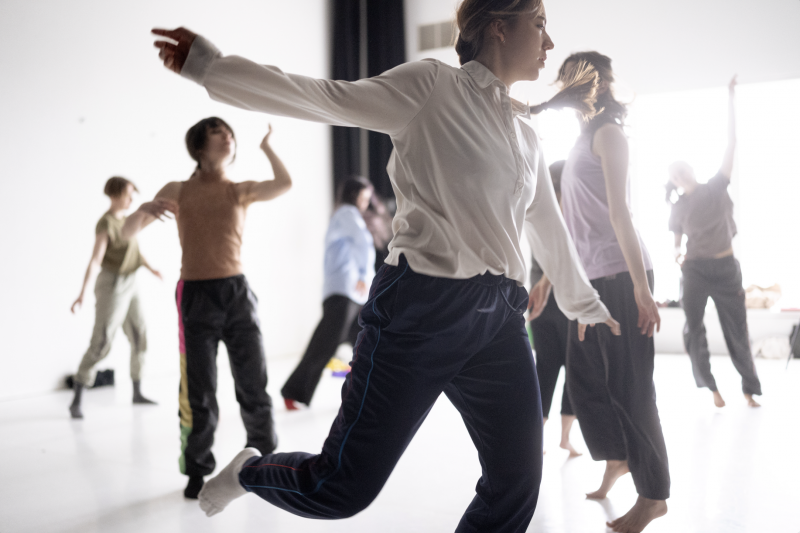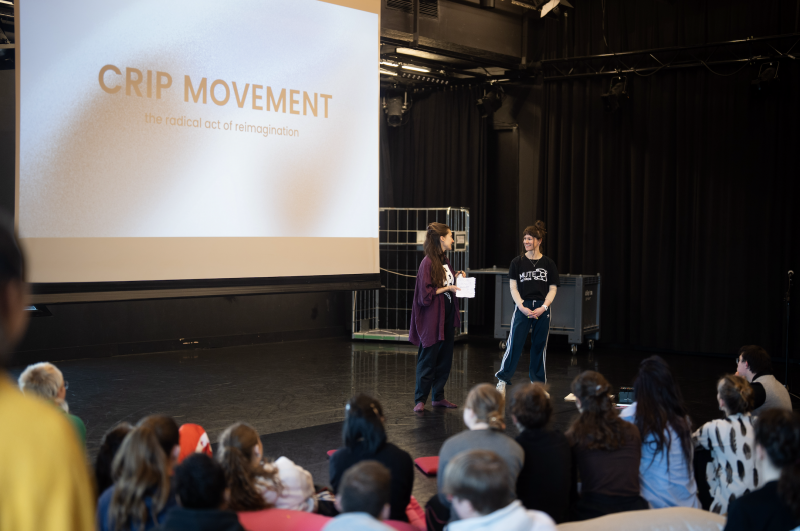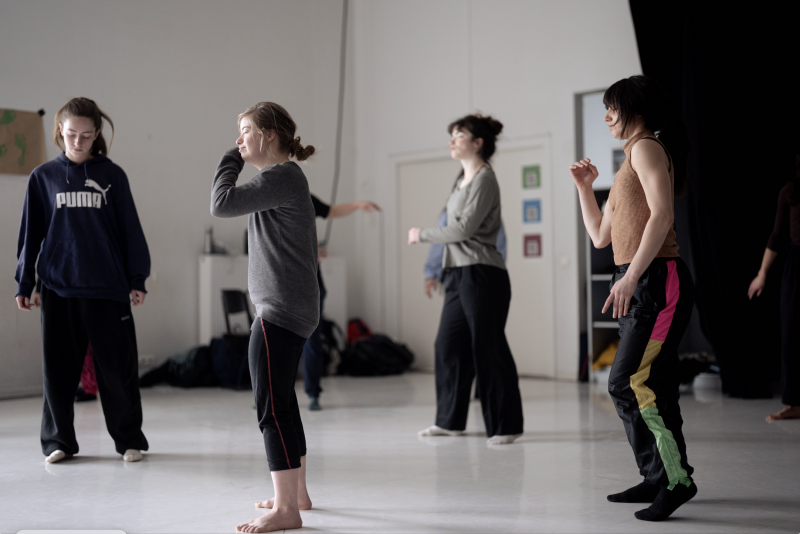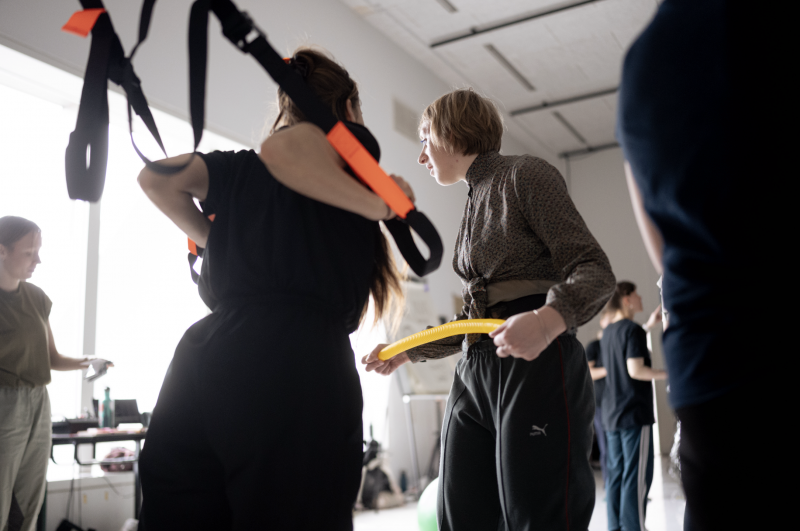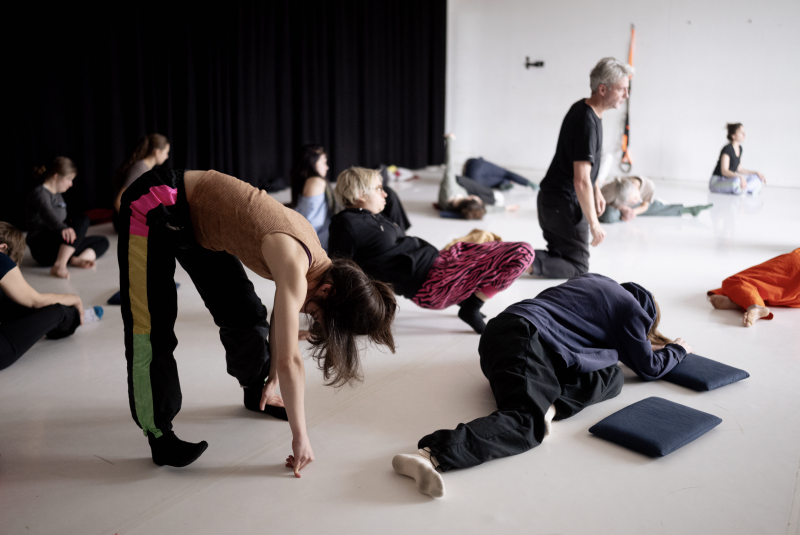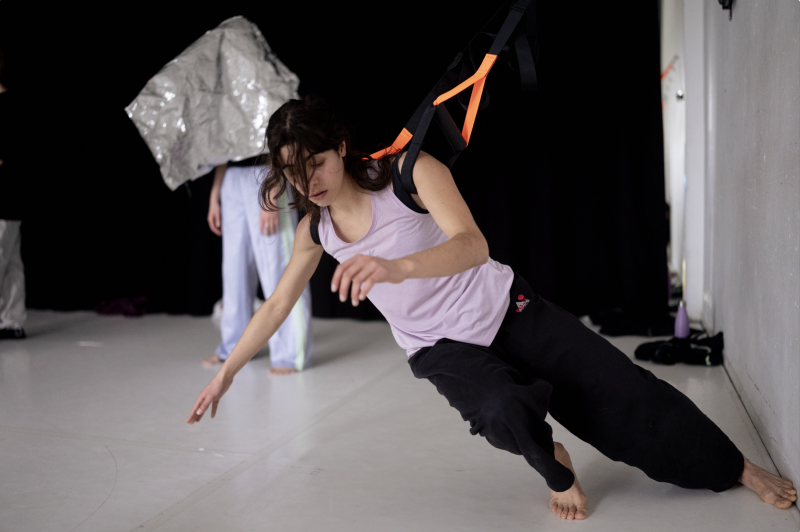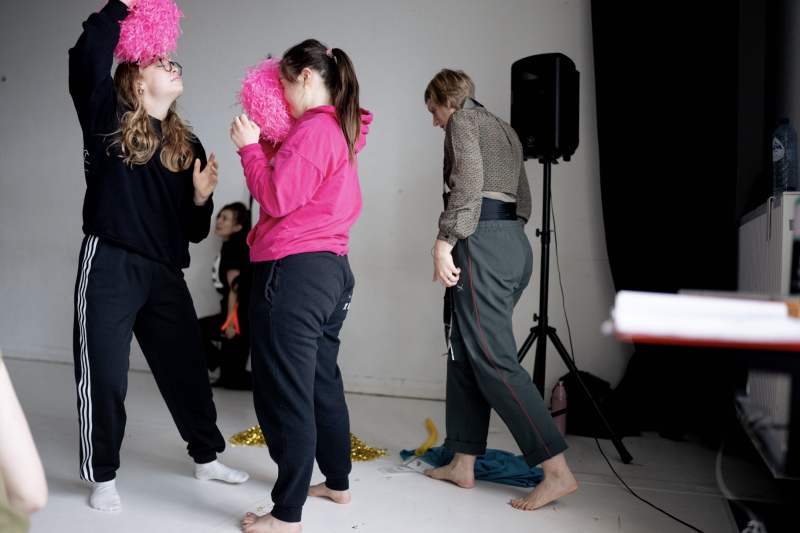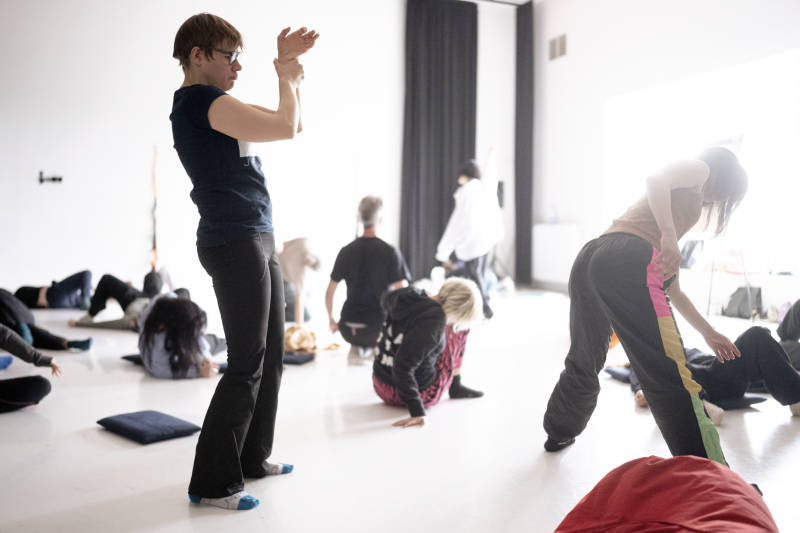MOVING BEYOND THE NORM: A CONVERSATION ON CRIP/PING DANCE (EDUCATION)
Read the reflection here.
MOVING BEYOND THE NORM: A CONVERSATION ON CRIP/PING DANCE (EDUCATION)
Platform K in collaboration with Bachelor Dance - Royal Conservatoire Antwerp
In February, Platform K set up camp at the Royal Conservatoire of Antwerp for a project week centred around inclusive dance practices. During the week, the students were introduced to inclusive methods and frameworks through workshops, lectures, talks, a dance jam and documentary.
Through critical, curious and caring exchanges on and around the dance floor, we dove into themes such as dancing with a disability, Crip theory and aesthetics, dance education and potential structures and spaces of care and creativity.
We concluded the week with a panel talk on Crip/ping dance, reflecting on and sharing the thoughts and feelings which arose from the exchanges during the week, together with performance artist and researcher dr. Aby Watson, actors and theatre makers Mira Bryssinck and Sander Deckx, and Platform K dancers Carlien Foucart and Oskar Stalpaert, moderated by prof. Leni Van Goidsenhoven.
We gather in the Conservatoire dance studio, where, during the past week, the students of the Royal Conservatoire have been exploring different ways of approaching inclusive dance practices, together with the dancers and coaches of Platform K. People take place on the pillows, chairs and mats scattered across the floor, with some stimming toys, large papers and markers in between the inviting seats. A large circle forms on the dance floor, with the speakers in the middle.
"The extra work that needs to be done to be able to navigate a mainstream educational environment, often keeps me from being fully present there."
It’s not necessarily a given that we’re gathering in the studio of an institutionalised educational setting, or that we feel at home there, the speakers emphasise. It’s not easy to navigate the mainstream dance world, Watson explains: ‘I always knew myself as a dancer very naturally, but at the same time, I felt very much outside of the systematic choreographic dance environment. When I went into dance training, I had a very traumatic experience. It was the first time that I couldn't mask in a learning environment. And in a uniform dance environment, it’s so clear if you’re the odd one out. It essentially comes down to “if you cannot keep up, get better or get out.”’ The affirming nods reveal that she’s far from the only one with this experience. Foucart adds that the extra work that needs to be done to be able to navigate a mainstream educational environment, often keeps her from being fully present there. This, she stresses, is why places like Platform K are important: ‘Being at Platform K, it’s like I’ve met a family, I was seen from day one. We’re dancing together from the same places in the body, in the mind, in the feelings. That is something I know I probably cannot find in another place.’
How, then, do you navigate the mainstream field as a disabled dancer? What opportunities and spaces are there? To what extent are they accessible and to what extent can you stretch their potential? When and where do we create alternative spaces and ways of radically reimagining our notions of dance?
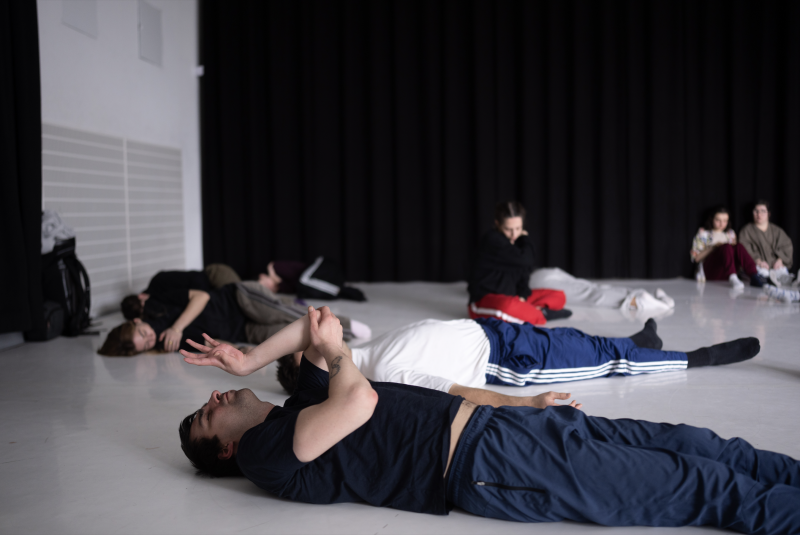
Early on in the conversation, the need for and value of spaces like these is made clear. But, when we’re segregated from a very young age, especially in educational settings, these ‘diverse spaces’ don’t just emerge organically, the panel agrees: ‘It is much too often the case that we are expected to create these spaces ourselves’. ‘I’m teaching drama to young children now’, Deckx shares, ‘and recently, a little boy asked me: “Did you ever go to school?” I asked him why he wanted to know, and he said, “Because you can’t go to school in a wheelchair.” ‘I tried to explain it to him,’ Deckx continues, ‘and I could see he had a million questions. I’ll keep answering them, as I am aware that I am making a difference in these children’s lives — but it isn’t my purpose, it is not why I’m there.’
‘And it shouldn’t have to be your responsibility’, Watson underlines.
Welcoming diversity by creating accessible spaces should be a shared responsibility, Foucart underlines, reflecting on her experience as a teacher: ‘When you work in an educational context, it’s often said that you are an example to students, that you are inspiring, yet these same environments make it impossible for me to stay when my body refuses to function in a certain way.’
‘And what does ‘accessible’ even mean, then,’ Watson adds, ‘In what way and for whom — because different access needs are often in conflict.’ When we talk about accessibility, we need to be precise: ‘If something claims to be ‘fully accessible’, I am always a bit suspicious’, Watson explains, ‘does that mean that an environment is completely non-verbal? Do you have customised support? Or does it just mean that the building has a ramp?
"It’s often said that you are an example, that you are inspiring. Yet, these same environments make it impossible for me to stay when my body refuses to function in a certain way."
And it’s not only about making spaces (more) accessible, as Deckx points out: ‘If you want people with a disability to be there, you have to get them; the threshold is so high, you have to reach out.’ The work doesn’t end once they are simply present in these spaces, the speakers stress: ‘There’s this idea that if you made it this far, you can do it on your own, but it’s not because we got here that it’s easy.’
Highlighting the importance of a continuous support framework, Stalpaert explains: ‘I do feel at home whenever I enter the context of a theatre or studio, because I love it so much, but if the rehearsals are in English, I need someone to translate for me. I love watching the Flemish soap Familie and, there too, the subtitles really help. It’s very similar on the dance floor.’
That these needs are often overlooked, or simply disregarded, is illustrated by, for example, the conventional (fast-paced) logic of production, the language used in communication texts or the accessibility of the building, but also (the structure of) the disability allowance and the lack of information on it. ‘I don’t sleep at night thinking about it’, Deckx admits. The burden of navigating environments not designed for you doesn’t disappear once you're inside.

In creating these spaces and (re-)shaping them, we quickly run up against structurally imposed boundaries, it seems: ‘You can join our programme, but we cannot give you a degree’, artistic coördinator of the Bachelor Dance Nienke Reehorst adds, underlining her frustration about the limits of the educational system when trying to create inclusive learning environments. That said, it is crucial to search for the grey areas, to work around the system instead of waiting for it to change, Foucart emphasises: ‘If we continue to think black and white, we will never get anywhere. It’s step by step, our lives already exist in grey areas all the time.’
The need for these so-called grey zones, once again raises the question of how to relate to spaces and frameworks that are often harmful to you: how can you move outside of them and, in doing so, radically re-imagine what movement can mean?
"It's not about fitting into the mainstream system, or improving it by making it more ‘accessible’, but rather about questioning the very system itself."
Watson describes how she started her research with the title Choreographing Clumsy and how, halfway through, she realised she was still seeing herself as the problem — while, as she reiterates, it’s the way in which we understand choreography and dance education in general that is inherently problematic. From there on, she decided to ‘purposefully fuck with those norms and destabilise them, instead of changing myself.’ It is from this shift that her research on Stimprovisation emerged, she clarifies. It is thus not (just) about fitting into the mainstream system, or improving it by making it more ‘accessible’, but rather about questioning the very system itself. The grey areas should spill into the neatly separated black and white, to eventually mess up their closely guarded boundaries.

This, of course, doesn’t mean it’s easy to carve out a space in between, Watson underlines: ‘When I started dancing, neurodiversity wasn’t a very prevalent term. I often felt like I wasn’t disabled enough to access the so-called ‘inclusive environments’, let alone to receive support in a dance environment. I didn’t want to claim a space that I felt was less ‘mine’, but at the same time, I was constantly disabled by the normative dance environments. In my PhD, I call this the ‘unseen inbetween’. She goes on to underline the importance of moving away from a binary notion of disabled / non-disabled, where neurodiversity and invisible disabilities are often excluded or disregarded, and emphasises the importance of Crip culture and the community around it in bridging those gaps. ‘I was living in Glasgow at the time and there were all these incredible Crip choreographers such as Caroline Bowditch, Claire Cunningham, Kate Marsh, Dan Daw,... I distinctly remember talking to Claire Cunningham — she does this thing where she positions a crutch and leans on it and she looks cool as fuck — and she said “Us Crips gotta keep together”. That meant a lot to me. I wouldn't be where I was today if it wasn’t for these people seeing me in this way.’
Watson’s experience only proves the need for physical as well as ideological spaces to support the messy work that happens in the inbetween, to create opportunities for dancers and makers without expecting them to (want to) move inside a certain norm. But, as the speakers observe, when you move outside of these norms, you are easily reduced to your disability. How, then, do the speakers relate to so-called ‘inclusive’ (dance) practices, or the notion of crip(ping)? Do they claim it? Redefine it? Move away from it?
"Very often, my performances get labeled ‘inclusive’, as if only then, they have a right to exist. As if people need to be prepared for what they are going to see on stage: a boy who has a body that doesn’t fit the norm. Imagine someone walking in without knowing beforehand that I am in a wheelchair!"
‘I really dislike the word inclusive’, Deckx explains. ‘I do use the word Crip for myself, because that’s about me. Inclusive is what people like to imagine a group or a space becomes when I enter it.’ ‘You are included in someone else’s structure’, Watson affirms. Very often, Deckx notes, his performances get labeled ‘inclusive’: ‘As if only then, they have a right to exist. As if people need to be prepared for what they are going to see on stage: a boy who has a body that doesn’t fit the norm. Imagine someone walking in without knowing beforehand that I am in a wheelchair!’ It’s a very limiting label, the speakers concur. ‘I am not inclusive, I am not diverse, I am a Crip person, a Crip artist, but I am not here to make your education system inclusive’, Deckx stresses. The panel agrees: ‘If the word inclusive isn’t used, does it automatically imply exclusivity?’ This rigid distinction feels highly reductive, they conclude.
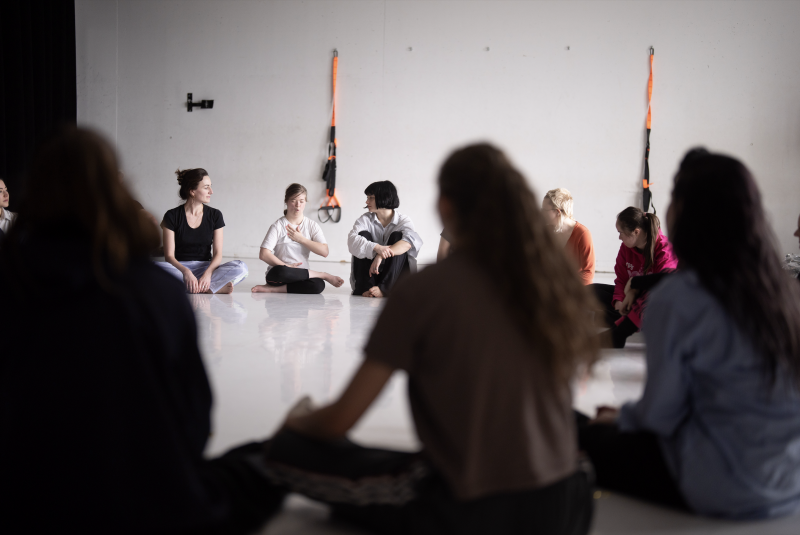
‘At the conservatoire’, Bryssinck further explains, ‘I was taught how to act and perform — how to “do it properly”. I came out of that thinking: Great, now I know how to do it, and no one has any business questioning my disability. Then, I entered the professional scene, and suddenly the question arose: Oh, but you’re a disabled actor — how does that work? It was confronting. I remember how journalists and critics responded to my first solo, mentioning my disability before even engaging with the work itself. As if that was the headline, and the art came second.’ Deckx, too, recognises this reductive thinking, pointing to how his disability is often foregrounded as the defining feature of his identity, while simultaneously being reduced to a narrow and simplistic understanding of it: ‘we are layered, and disability will always be a layer of that. I’ve found that my gayness, my Queerness, my fabulousness, my crip, my disability,... lay in a very similar place. They are all things I cherish, and they’re very much intertwined: when I make something about my Queerness, I’m also making something about disability and vice versa.’
"I remember how journalists and critics responded to my first solo, mentioning my disability before even engaging with the work itself. As if that was the headline, and the art came second."
And to reduce ‘Crip’ to something (purely) identitary doesn’t cover it either, Watson adds. She goes on to underline the distinction between ‘Crip’ as an identity, as opposed to a practice: ‘For me, Crip is more about an approach than a thing about one’s person’. Neuroqueering works in a similar way, Watson explains: ‘It’s first and foremost a verb, a doing. anybody can neuroqueer, regardless of your identity as a neurodivergent person or not, or your sexuality or gender expression — because if you take actions that purposefully fuck with the idea of a dominant normal type of thinking, feeling, being, behaving, then you are neuroqueering. And this works both ways: ‘as a disabled person, you can absolutely say “I just want to act”, that is fucking radical too.’
Labels like ‘disability aesthetics’ or ‘Crip art’ thus shouldn’t be read unambiguously, the panel agrees. It’s much more complex than a simple act of reclaiming. And it’s strongly culturally determined. ‘In the context of Flanders, I don’t necessarily say I am a Crip artist’, Bryssinck explains. ‘People with disabilities are already segregated from primary school on, I don’t want to further cultivate that separation. I am an artist and apart from that, I have a disability. Get over it.’ She goes on to explain how, in the Flemish context, work by and with people with disabilities often falls under the denominator of socio-artistic work, under separate funding. And how this has become a limiting box: ‘The initial idea was to give more platform to this kind of work, but now we immediately read work by a disabled performer as socio-artistic.’ Bryssinck visibly weighs her words: ‘Maybe if I would live in Scotland, I would be more likely to present myself as a Crip artist, who knows. Maybe this will change, but that’s the freedom I want to have.’
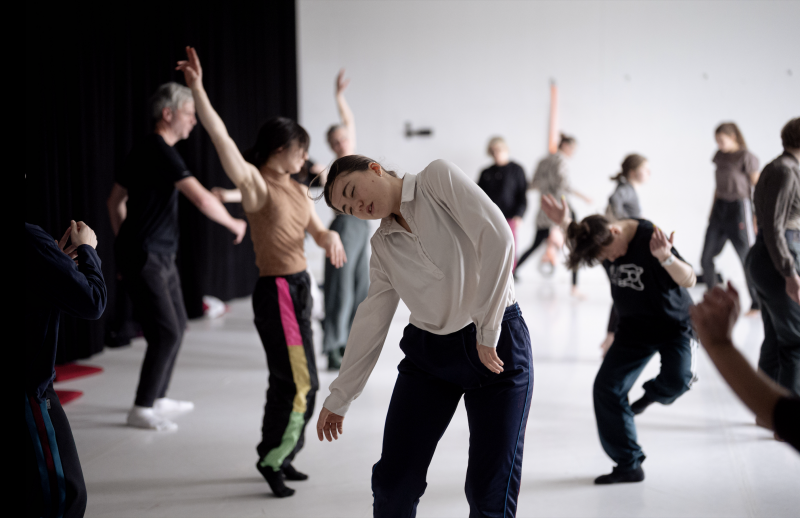
It’s a constant negotiation, the speakers agree: you don’t want to be reduced to your disability, while, at the same time, you are fighting against it being disregarded.
In this context, Bryssinck refers to a text she wrote a few years ago, in which she imagines her disability as a closet she always carries with her: ‘...it’s a closet, big and bulky. And it never seems to fit through the door.’ ‘Sometimes’, she explains, ‘I think: I need to move to another house — but what do I do with the closet? Where should it go? Does it fit through the door? Is there enough space for it? In those moments, the closet becomes impossible to ignore, it demands attention. I have to talk about it, ask others for help to move it, to make space for it. Eventually, I find a spot for it in a room and think: Okay, it’s there — but now no one can see it. And before I know it, I have to move again.’
It’s a lot of work, the speakers confirm. And it doesn’t help if that work is invisibilised: ‘Because we see no dancers or actors with a disability, we say they aren’t there. And because we say they aren’t there, we don’t see them’, Bryssinck concludes. Stalpaert agrees, underlining the importance of representation: ‘In the theater company I work with, there are two other actors with Down who have already acted in Familie, which is my dream too. It’s really nice to see and know that this is possible, that I can do this too’. It is, however, about more than (just) visibility, Deckx adds, pointing out the lack of diversity and imagination: ‘If you see people in a wheelchair on tv, we’re always so miserable! If we do get visibility, it’s often so heavy and sad, when do we see someone in a wheelchair who has a good life which they enjoy?
This is why disability authorship is so important in challenging ableist perceptions, Watson underlines. In this context, she points towards the more general need for exploring the intersections between disability and sexuality. ‘There’s this normative notion that disabled people aren’t sexual beings’, Watson explains, ‘confronting this idea through the potential of neuroqueer choreography is something I’m really excited about.’ And it’s not just about what’s happening on stage, she stresses, we have to reimagine the audience too: ‘Performances for neuroqueer audiences are often directed towards children or families, it’s palatable, it’s nice, it’s soft. Where’s the risky work? Where’s the radical work? All people have a right to culture, but the culture that neurodivergent people are able to receive is so limited!’ Watson here refers to the work of performance artist Dan Daw — ‘Crip, Queer, kinky, sexy’. ‘There’s an ableist fear around Queer and Crip sexuality, or the more risky material, but we want to have exciting and sexy times too!’ ‘At the same time’, Foucart adds, ‘I don’t always want to be “radical”, or have to do radical things to be seen. Of course we want to be free and adventurous, but don’t make heroes out of us. Don’t only listen when we tell exciting stories.’
"I don’t always want to be “radical”, or have to do radical things to be seen. Of course we want to be free and adventurous, but don’t make heroes out of us. Don’t only listen when we tell exciting stories."
There’s no ready-made recipe, then, for creating and cultivating spaces that hold this multitude of stories. That’s precisely why we should understand Crip/ping as something fluid, an ongoing and ever evolving practice, the panel agrees. And that it’s a shared responsibility to keep things moving — towards a more imaginative and polyphonic field. Crip/ping is a critical practice of care, the speakers conclude, and an inherently collective one: ‘Much of what disabled movers and makers have long been practicing, turns out to be beneficial for everyone. And it might be exactly what we need to move beyond normative notions of dance — in our imagination, education, on and off the stage.’
In collaboration with Bachelor Dance - Royal Conservatoire Antwerp
Many thanks to Nienke Reehorst
text by Margot De Grave Loyson
all images by Rudy Carlier

